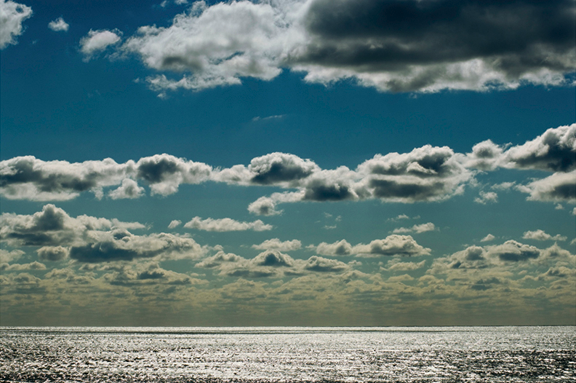Art Review: ‘Phil Nesmith: Flow’ at Irvine Contemporary & Renate Aller at Adamson Gallery
By Jessica Dawson
Last weekend, Thad Allen promised we’d seen the last of it. Relief well, check. Concrete wedged thousands of feet underwater, check. Five months and countless millions of gallons of spewed oil later, the Deepwater Horizon blowout looked to be under control.
Now, as environmentalists speculate on the long-term damage to shrimp and plankton, artists are assessing the damage to our psyche.
The most vexed work to emerge from the tragedy so far comes from Canadian photographer Edward Burtynsky. This is the Burtynsky of those gargantuan color images, the ones documenting the stark beauty of mining sites and oil pipelines — images that had us shuddering before the spill and now come off as nearly demonic. (We wince recalling the name of his Corcoran Gallery of Art-organized exhibition last year: “Edward Burtynsky: Oil.”)
Last week, the photographer’s aerial views of the slick, shot in May and June, went on view at Toronto’s Nicholas Metivier Gallery. In the new images, Burtynsky has crafted something beautiful out of the tragedy — unsurprising stuff from this veteran image-maker. But what’s troubling is how the pictures’ remarkable formal appeal casts the spill’s real cost — in human and animal suffering — into the realm of abstraction.
Which is why, right now, I prefer what I’m seeing here in Washington, at Irvine, a gallery that has mounted one of its meatiest shows yet (more, please!). “Phil Nesmith: Flow” is equal parts sublime and sorrowful. These 22 pictures of coastal Louisiana and Mississippi, made by the Richmond-based Nesmith back in June, don’t entirely escape the Burtynsky trap of beauty — their rich monochromes and narrow lines of focus create gauzy scenes. But Nesmith’s pictures, created using antiquated photographic methods, have a compelling gravitas.
To make them, Nesmith reached into the Pleistocene era of photographic history. He used a process called “wet collodion,” a multi-chemical, hurry-up-and-finish-while-it’s-still-wet ordeal that hasn’t been cutting edge since 1850. Presented on small glass plates hung on the gallery wall, the exhibition is testament to Nesmith’s radical, and possibly certifiable, patience.
(In a theatrical nod to Nesmith’s old-school methods, the gallery outfitted the exhibition space with his “portable” darkroom — a fitting adjective only if you’re on a Barry Bonds regimen — and the massive view camera he used to take his pictures.)
Why so retro? Because the height of the collodion method coincided with what Nesmith cites as America’s first commercial oil rush, marked by the digging of a Pennsylvania well in 1859.
At Irvine, you’ll have to remind yourself that these are from 2010, not 1870. What’s new looks very, very, old: Images of the latest oil clean-up technologies — pom-poms and booms, which Nesmith captures in massive heaps — make a brutal visual essay on impotence. And the all-terrain vehicles used for beachside clean-up operations, as seen through Nesmith’s lens, have the buggy-like look of a Ford Model T. We wonder: Is this really the best we can do?
The ghost of Walker Evans lives in these pictures, too. Nesmith’s depictions of simple Louisiana shacks and a stark clapboard meeting house honor vernacular architecture as Evans might.
In these pictures, Nesmith acts as if the spill is already history. Like Burtynsky, he’s buffering us from cold realities. But in historicizing the disaster, Nesmith also folds in a sense of humility in the face of tragedy. The long-term ramifications of the disaster? We just don’t know. History is written in every passing moment. The rest, as they say, is present.
Aller at Adamson Gallery
(Fall 2006) 3:21 pm (Adamson Gallery)
I like routine the same as the next person, but does anybody love repetition as much as Renate Aller? In a love letter to Long Island, she returned, each year for 10 years, to the same spot on the beach. There, she trained her camera out to sea, capturing grand images of sky and water. Eleven prints on view at Adamson Gallery testify to her devotion.
Aller treads familiar territory — you can’t help but think of Vija Celmins and Hiroshi Sugimoto — but her results are often remarkable. The sliver of ocean at the bottom of a fall 2006 picture looks like crinkled tinfoil. In spring 2007, Aller captured a wave licking the ocean’s surface like a cat’s tongue.
Adamson’s exhibition leaves half of the decade out. The gallery says this was a “curatorial choice.” To me, it’s curious to mount a show about a project and leave its early years unrepresented. But perhaps 2000 wasn’t as photogenic as I’d remembered.
Dawson is a freelance writer
“Phil Nesmith: Flow”
At Irvine Contemporary, 1412 14th St. NW, Tuesday-Saturday, 11 a.m.-6 p.m., 202-332-8767, to Oct. 30. http://www.irvinecontemporary.com.
Renate Aller
At Adamson Gallery, 1515 14th St. NW, Tuesday-Friday, 11:30- 5 p.m., Saturday, noon-5 p.m., 202-232-0707, to Oct. 23. http://adamsongallery.jimdo.com.
